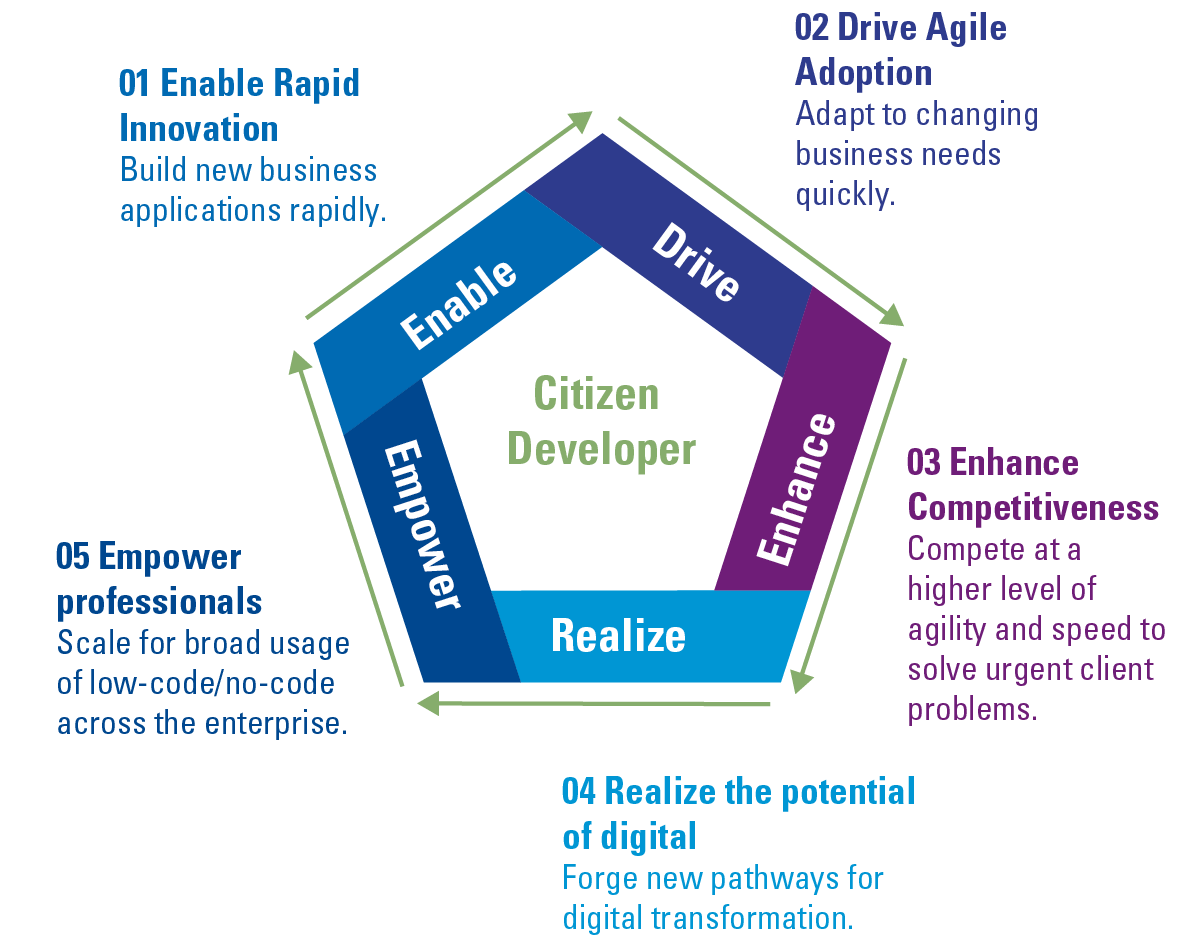Right now, businesses are facing the perfect storm. Digital transformation is high on every organization’s management agenda, with global spending in this area forecast to reach 2.8 trillion US dollars by 2025 ([Sava22]). Leaders are recognizing this opportunity, with 72% agreeing they have an aggressive digital investment strategy, intended to secure first-mover or fast-follower status ([KPMG22]). This potential momentum is threatened however by a gap in the available talent required to make it a reality. Currently, there is a global talent shortage of 4.3 million skilled workers in the telecoms sector alone, resulting in unrealized project output projected at 449.7 billion US dollars ([Binv18]); 86% of IT decision-makers say the biggest challenge to digitally transform their business is too few software developers ([PMI20]).
Pushed by market forces to become more agile, innovative organisations have recognised that maturing next generation technologies like microservices and containers, alongside development models such as low-code/no-code, are opening up an entirely new way to respond to the challenges and opportunities they face. At a time of constrained budgets and a need to dramatically accelerate change, these technologies are enabling business leaders to turn to their own workforce and enlist them as Citizen Developers to speed up innovation.
These employees are perfectly placed to understand how to make changes that will improve services or create new revenue opportunities. They are the ones on the frontline, interacting with customers and are best placed to identify ways to adapt business processes. Citizen development is also considered to be a tool through which organizations can concretely create a culture of innovation and continuous learning.
“92% of global IT decision makers believe this is an effective way to foster a culture of innovation and continuous learning.”
– PMI Research ([PMI20])
So how do companies unleash the potential of these Citizen Developers?
First, let’s explore the meaning of low-code/no-code
Perhaps first it’s important to understand low-code/no-code and how it works. As Gartner has indicated, these terms can be somewhat interchangeable and are sometimes overused for marketing purposes by vendors ([Wong21]). Simply put, “low-code” means that there is a minimal requirement to understand how to code in order to build an application. “No-code” implies there is no need to understand computer coding to build business functionality or applications. In reality, of course, there is always some level of coding involved so “no-code” is really much more of a convenient marketing term.
Low-code development platforms work employ visual, declarative techniques that make it possible to develop software using model-based rules. The development mainly happens within visual graphical user interfaces that are easier to grasp than traditional “green screens” as used by programmers. This means that low-code programming involves more configuration with models and following rules to build an application, rather than having to follow the traditional approach of writing software code.
Not only does this speed up software development and shorten time to market, but it also frees up time for development team’s brain power and it makes software development more responsive and accessible for the business ([Tiem19]).
In principle, it should enable the business and IT to truly converge, enhancing mutual understanding and fostering a more agile way of working. However, not everyone is as keen on the idea of armies of Citizen Developers springing into action.
Understand the tension between IT and business
The fact is that people are more digitally savvy today than ever before, with every aspect of daily life now digitized in one way or another. This has led to an increased expectation from employees to work in environments that are equally digitally enabled, adding some tension between IT and business. Citizen Developers are considered a bridge between the gap between accelerated technological evolution and the talent available to meet this rise in demand.
The concept of Citizen Developers has been around for some time and has consistently been portrayed to – and by – the IT department as a bad thing. It has been perceived as encouraging “Shadow IT”, this semi-sinister world of rogue IT applications beyond the control of the IT department. Besides the added complexity of unknown applications being added to the corporate IT environment, the dangers of security vulnerabilities was seen as very real.
Even back in 2019, a study by Dimensional Research and Mendix showed how glaring the divide between IT and the business had become ([Dime19]). Seventy per cent of respondents in IT departments thought it was bad when the business implemented IT outside of its control, while 69% of business stakeholders thought it was mostly good to act on their own. Indeed, in the same survey 58% of business stakeholders would rather build applications themselves than explain their ideas to IT.
Managing risk and enhancing collaboration
Clearly, such an atmosphere is incredibly unhealthy for any organisation looking to embrace IT-led transformation. Thankfully, both the understanding of the technology and the technology itself have matured significantly since 2019. Furthermore, given the current business climate, it is almost imperative that every business finds a way to address the concerns of the IT department, but still empowers the business to become Citizen Developers. Citizen Developers providing measurable value to the organization (see Figure 1).
Figure 1. Key Citizen Developer Value Contributions ([KPMG22]). [Click on the image for a larger image]
With such potential benefits in sight, the business case for Citizen Developers is incredibly strong. However, the security of unmanaged applications is a concern to many. KPMG’s 2021 CEO Outlook Pulse survey showed that cyber security risk is the greatest threat to company growth right now. Simultaneously, Gen Z workers in their desire to innovate are also the most likely to circumvent security policies in the name of productivity. Flexibility to innovate is key, but there is a need to put structure and accountability to this.
So, how do you encourage these individuals without creating unnecessary headaches?
Before letting any Citizen Developers loose, it is critical that business and IT leaders provide the proper standards, frameworks, governance, and guard rails to avoid application sprawl — and to protect and secure the enterprise. There are three areas of focus to address when setting up such a framework for Citizen Developers:
The design of the user experience:
- Setting business rules and workflows
- Establishing a standard process to integrate applications and data
These foundations should be combined with the right governance, which should concentrate on:
- Platform governance (for ownership, strategic direction, quality/budget control)
- (Data) Architecture (for interoperability)
- Standards and guidelines (for coding, security/privacy, version control, etc.)
- Continuous improvement (for lifecycle management, functional adjustments)
Putting these parameters in place ensures that standards and policies are understood by everyone and adhered to. Ultimately, it will avoid anyone going off-piste when developing new solutions based on Low-code/no-code.
It is also important to have the right training and oversight in place to support Citizen Developers according to their skill levels and experience. Someone operating in a low-code environment will need to have a certain level of IT knowledge, while no-code should be much simpler for non-technical employees to get to grips with, but there should be the right support available to guide them. If employees are starting out on their Citizen Developer journey, there should be an experienced IT professional who understands the appropriateness and when low-code or no-code should be leveraged including the adequate oversight level of the project. As Citizen Developers become more skilled, the level of oversight can be scaled back while ensuring there are regular check-ins and clear parameters set for the development and deployment of applications.
Citizen Developers should be considered part of rather than a replacement of the broader IT function to avoid inefficient workflows, process logic errors, and poor user experience design. This can be mitigated with the practice of using a central hub where best practice and documentation is shared, continual upskilling of the Citizen Developers and strong team leadership to oversee the planning, design and build. The central hub should also include a repository of previously created features to avoid unnecessary replication of existing designs.
Managing office space post-COVID
The task
The pandemic has forced the adoption of new ways of working. Many companies around the world have risen to the occasion, acting swiftly to safeguard employees and migrate to a new way of working that even the most extreme business continuity plans hadn’t envisioned.
To accommodate the changed office working conditions in the wake of the post-COVID-19 era, KPMG Hungary found itself in a situation where it became essential to regulate, monitor and report office space usage and allocation in support of organizational policies.
The staff wanted to develop an intuitive and easy application for mobile (Android and iOS and desktop, to manage office space bookings.
Challenges requiring guardrails
- Creating a system to allow colleagues to easily and conveniently book spaces required having data on where all available equipment and workstation was located.
- Ensuring total cost of ownership e.g. licenses, development, maintenance was kept low.
- Ensure roles and permissions management follows industry standard IT security methods.
Solution and benefits
- The “KPMG Hungary – Internal Seat booking application” was created as a Microsoft SaaS service-based solution, offering a modern user experience via PowerApps and sufficient data storage capabilities via SharePoint Online. This kept additional corporate costs such as licensing and maintenance to zero as these tools are all available via the Microsoft Enterprise E3 license that is already allocated to the employees. The app provides a convenient and fast way to reserve hotseats in the office via a decorative floorplan and provides searching capabilities too.
- After development, the end-to-end implementation and maintenance support was provided by the Technology team of KPMG Hungary.
Results
- Close to no time spent on booking and managing office space.
- Increased transparency and search ability across all areas of the office.
- Easy access through corporate mobile and internal link.
Conclusion
Citizen Developers are a critical bridge to safeguarding innovation and technology development, enabling businesses a measure of breathing room as they focus on filling the talent gap in their Tech teams. As businesses look at capitalizing on the opportunities presented by low-code/no-code, it is essential that the outputs of this digitalization prove to be trusted, fit within the guardrails of governance and lifecycle management, additive solutions which reflect the spirit of the citizen development vision to innovate faster and to better support business processes.
References
[Binv18] Binvel, Y., Franzino, M., Laouchez, J.M. & Penk, W. (2018). Future of Work: The Global Talent Crunch. Korn Ferry. Retrieved from: https://www.kornferry.com/content/dam/kornferry/docs/pdfs/KF-Future-of-Work-Talent-Crunch-Report.pdf
[Dime19] Dimensional Research / Mendix (2019, September). Digital Disconnect: A Study of Business and IT Alignment. Retrieved from: https://www.mendix.com/resources/digital-disconnect-a-study-of-business-and-it-alignment/
[KPMG22] KPMG (2022). KPMG 2022 CEO Outlook. Retrieved from: https://www.kpmg.com/CEOoutlook
[PMI20] Project Management Institute (2020). 2020 Annual Report. Retrieved from: https://www.pmi.org/pmi-annual-report-2020/opportunity
[Rami21] Ramirez, J. (2021, November), Executive Essentials: Prepare for the Future of Work. Gartner. Retrieved from: https://www.gartner.com/document/4008036?ref=solrAll&refval=347109469
[Sava22] Sava, J.A. (2022, February 16). Spending on digital transformation technologies and services worldwide from 2017 to 2025. Statista. Retrieved from: https://www.statista.com/statistics/870924/worldwide-digital-transformation-market-size/
[Tiem19] Tiemens S., Brouwer, A. & Kumar, S. (2019). Low-code: empower the capability to accelerate. Compact, 2019(3). Retrieved from: https://www.compact.nl/en/articles/low-code-empower-the-capability-to-accelerate/
[Wong21] Wong, J., Vincent, P. & Jain, A. (2021, March 9). Quick Answer: What Is the Difference Between No-Code and Low-Code Development Tools? Gartner. Retrieved from: https://www.gartner.com/en/documents/3999071




